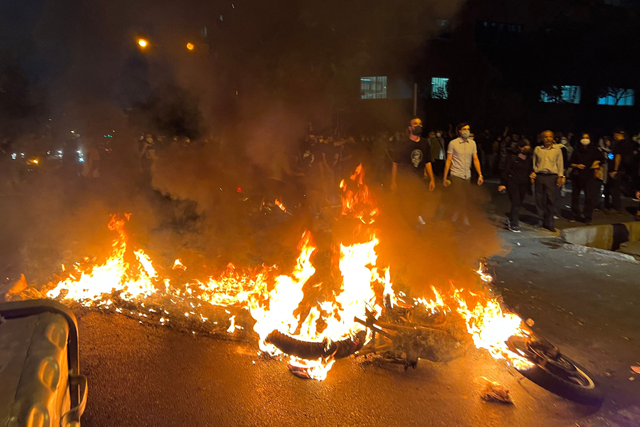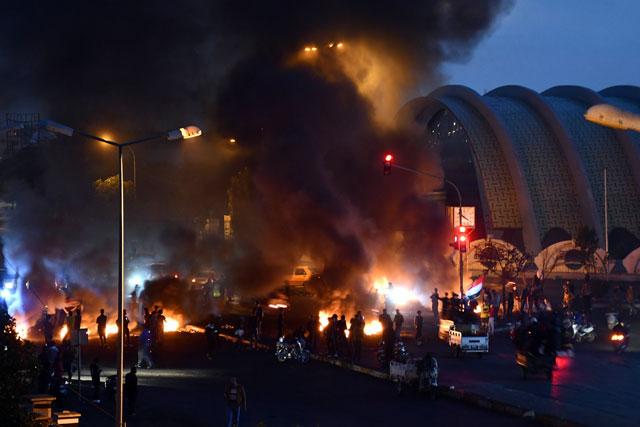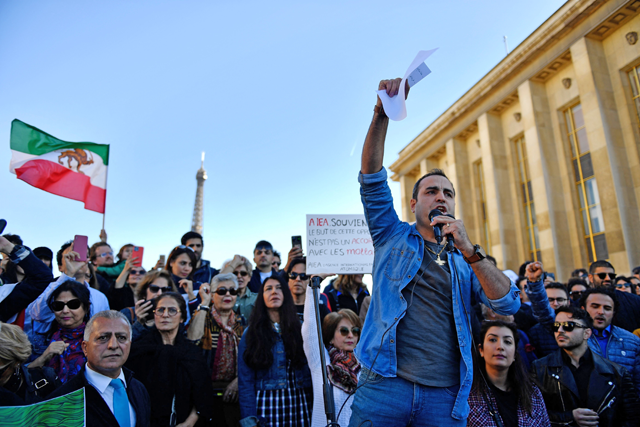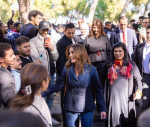You are here
Despite crackdown, Iran protesters still challenging regime
Jan 22,2023 - Last updated at Jan 22,2023

A file photo obtained by AFP outside Iran shows demonstrators gathering near a motorbike on fire during a protest for Mahsa Amini, a woman who reportedly died after being arrested by the Islamic republic’s ‘morality police’, in Tehran on September 19, 2022 (AFP photo)
PARIS — Despite a slackening of street activity in the face of a brutal crackdown, Iranian protesters are still challenging the Islamic regime four months into their movement, observers say.
There have been fewer daily street protests nationwide since November as the authorities seek to quell the protests with methods including capital punishment, which has already seen four protest-related executions.
But the anger unleashed by the death in mid-September of Mahsa Amini, who had been arrested for violating the Islamic republic’s strict dress rules, has not subsided.
At a time of economic crisis, it still poses a potential threat to the regime.
Meanwhile, protests have taken on different forms, notably including strikes.
Mass street actions continue in some regions, and there have been tentative signs of division within the regime.
“With the number of protests diminishing since mid-November 2022, it appears that a stalemate has set in, with neither the regime nor the protesters’ side being able to overwhelm the other,” said Ali Fathollah-Nejad, Iran expert with the American University of Beirut’s Issam Fares Institute for Public Policy and International Affairs.
“Revolutionary processes usually entail phases of both relative calm and uproar.
“Now, with a dramatic loss of the value of the Iranian currency since the turn of year, economy-driven protests could be expected, which as the past shows, could quickly turn political,” he told AFP.
The enqelab.info site, which monitors the extent of protest activity, said that while the number of street protests has decreased, the number of strikes and other acts of dissent such as writing slogans or damaging governmental banners has increased.
“The nationwide uprising is alive, though the manner through which people are expressing their dissent has transformed due to the authorities’ lethal crackdown during the fall,” it said in a statement to AFP.
‘Protests not over’
According to Norway-based NGO Iran Human Rights, at least 481 people have been killed in the crackdown and at least 109 people are facing execution in protest-related cases, in addition to the four already put to death.
On Sunday, 30 women political prisoners in Iran, including a Franco-Iranian academic and the daughter of a former president, demanded an end to protester executions.
The demonstrations began as a movement against the obligatory hijab rule for women but rapidly became a challenge to the entire system, calling for an end to the Islamic republic created after the 1979 ousting of the shah.
“Protests have not stopped in the face of the violent crackdown,” said Roya Boroumand, co-founder of the US-based Abdorrahman Boroumand Centre rights group.
“They have certainly subsided... We are also seeing cases of extrajudicial killings and, naturally, citizens are more cautious.”
But she said actions were continuing, including regular street protests in the vast and impoverished southeastern region of Sistan-Baluchistan, as well as strikes by oil workers and protests marking death anniversaries of protesters.
One notable example was a protest this month outside the walls of Rajaishar prison in Karaj near Tehran, when rumours emerged that inmates Mohammad Ghobadlou and Mohammad Boroghani were about to be hanged over the protests. Both men are still alive.
“These protests, whether they subside or not in the short term, are not over,” said Boroumand.
In the face of the challenge, there has been little sign the leadership under Ayatollah Ali Khamenei is ready to offer meaningful concessions -- and it could yet ratchet up the repression further.
‘Distrust among insiders’
Khamenei this month named former Tehran police chief Ahmad Reza Radan as commander of the national police force. Radan is a hardline figure seen as having played a key role in the suppression of 2009 protests over disputed elections.
Meanwhile, the crackdown on the protest movement has only increased Iran’s isolation from the West, with talks on reviving the 2015 deal on its nuclear programme in deep freeze.
Iran is also furious that the United Nations, at the instigation of Western countries, has launched a fact-finding mission into the crackdown.
Simultaneously, Iran has been increasingly running into the arms of Vladimir Putin’s Russia, similarly isolated by the West over its invasion of Ukraine. Kyiv and the West accuse Tehran of supplying Moscow with plentiful cheap drones to use in attacks on Ukrainian territory.
But some analysts detect the very first signs of fissures emerging over how to handle the protests within the regime, which despite all the bloodshed has yet to employ its full arsenal of repression.
In an extraordinary development many observers are still at a loss to fully explain, Iran this month executed former deputy defence minister Alireza Akbari, who had gained British nationality after leaving his post, on charges of spying for the UK.
Cornelius Adebahr, non-resident fellow at Carnegie Europe, said the “unexpected verdict” may point to a “power struggle” within the elite over how to deal with the protests.
Akbari was seen by analysts as close to Supreme National Security Council secretary Ali Shamkhani and other figures who have argued for some moves to address protesters’ grievances.
“Although no apparent cracks dividing the establishment could be observed four months into the protests, there are signs of fissures,” said Fathollah-Nejad, describing the execution as “another sign that distrust has set in among regime insiders”.
Related Articles
PARIS — Iranian security forces have killed at least 537 people in a crackdown on protests that erupted in September, a rights group said on
BAGHDAD — Two Iraqis were killed and dozens wounded in protest-related violence on Tuesday, as authorities suspended a television stati
PARIS — An international footballer, an influential tech-blogger, a woman who was merely eating her breakfast without a headscarf.In Iran no
















